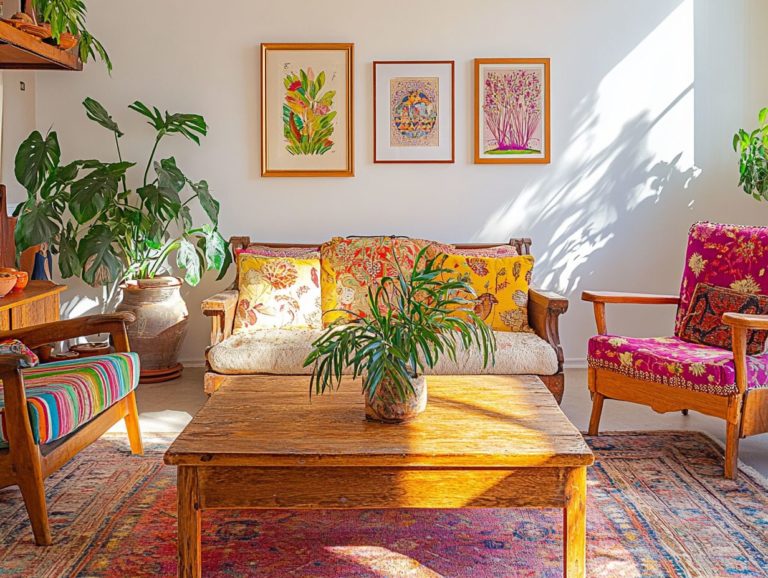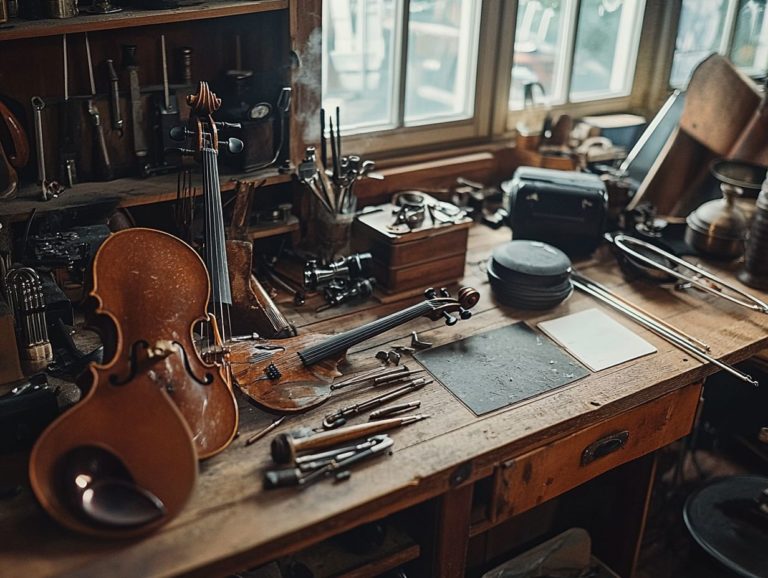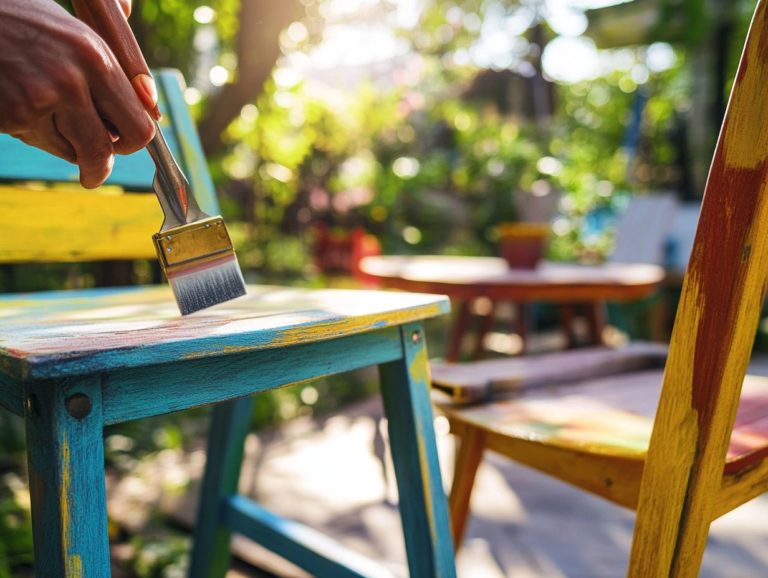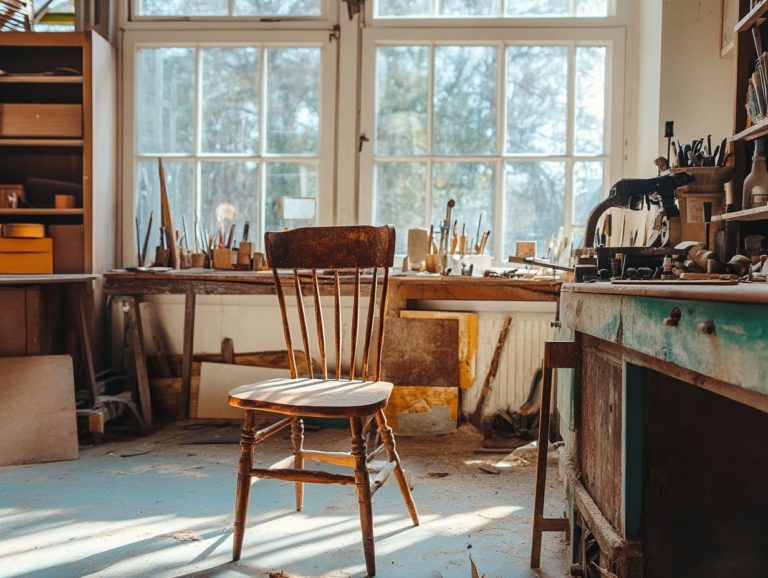How to Restore Vintage Lighting Fixtures
Get ready to dive into the world of vintage light fixtures! If you re enchanted by their allure but feel uncertain about how to bring them back to life, this guide will lead you through the process. You ll learn how to recognize the qualities that define a truly vintage light fixture, evaluate its condition, and understand the latest vintage trends.
This guide includes a comprehensive overview of essential tools for restoration, a detailed step-by-step process for cleaning and repairing vintage lighting, and invaluable tips for preserving these cherished items. Discover the best sources for authentic vintage shopping that can elevate your space.
Immerse yourself in the art of restoring vintage fixtures and unveil the secrets that await!
Contents
- Key Takeaways:
- Assessing the Condition of a Vintage Fixture
- Tools and Materials Needed for Restoration
- Step-by-Step Guide to Restoring a Vintage Fixture
- Tips for Maintaining and Preserving Vintage Fixtures
- Where to Find Vintage Lighting Fixtures
- Frequently Asked Questions
- What are some common issues with vintage lighting fixtures?
- What tools will I need to restore a vintage lighting fixture?
- How do I safely rewire a vintage lighting fixture?
- Can I clean a vintage lighting fixture without damaging it?
- How can I repair a broken or missing part on a vintage lighting fixture?
- How can I keep my restored vintage lighting fixture safe?
Key Takeaways:
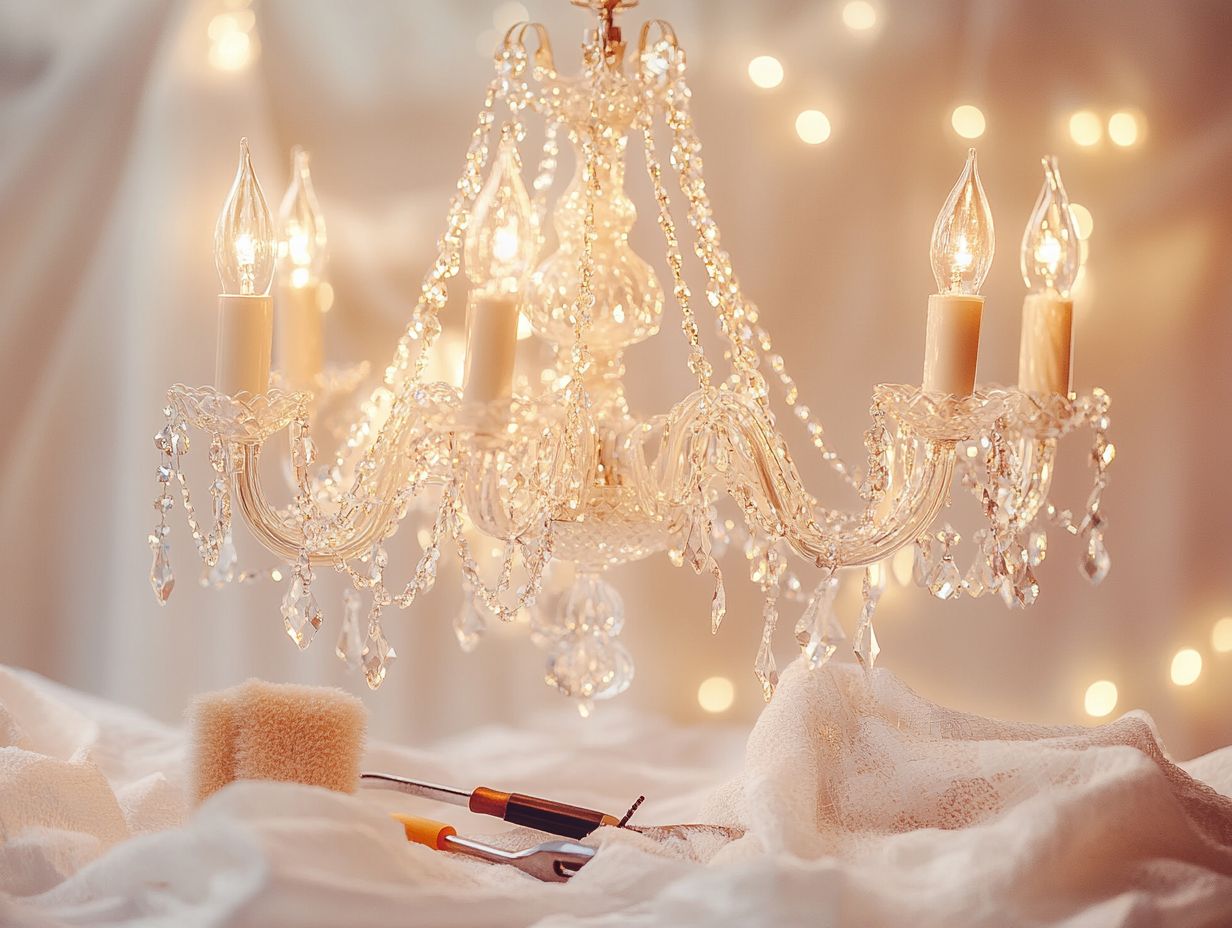
- Identify what makes a light fixture “vintage”.
- Assess its condition before restoration.
- Use the right tools to ensure a smooth restoration process.
What Makes a Fixture “Vintage”?
A vintage light fixture is not just about its age; it s a piece of history that tells a unique story through its distinctive craftsmanship (the skill in making something) and design. These fixtures embody the trends of their time. You can uncover these treasures at vintage flea markets, estate sales, or specialty shops that cater to those who appreciate secondhand home goods with character.
The charm of vintage lighting lies in its perfect blend of functionality and artistic flair, making it an exquisite addition to your home decor while infusing a touch of nostalgia.
To spot a vintage light fixture, start by examining key design elements like intricate detailing, unique shapes, and ornate embellishments these features often set them apart from modern fixtures. Pay attention to the materials, such as gleaming brass, delicate glass, or robust steel, as they offer hints about the fixture’s era and origin.
For example, Art Deco pieces may flaunt geometric patterns and polished metals, while Mid-Century designs often showcase sleek lines and vibrant colors. Appreciating the historical significance of these vintage materials will deepen your understanding and allow you to seek out pieces that resonate with your personal style and spark engaging conversations in your home.
Assessing the Condition of a Vintage Fixture
Before embarking on the restoration journey, assess the condition of any vintage fixture. This careful evaluation ensures that necessary repairs and restorations are executed safely and effectively.
Begin by identifying any damage, wear, or missing parts. This will help you decide whether you require professional help or if a DIY restoration approach is within your skill set. By examining each component carefully, paying close attention to wiring safety and structural integrity, you can establish restoration goals that honor and preserve the fixture’s timeless charm. For a thorough process, check out this step-by-step guide to restoring antique lamps.
Identifying Damage and Wear
Identifying damage and wear in vintage light fixtures is crucial in your restoration journey, guiding your strategy for repairs and replacements. Common issues may include broken chandelier crystals, tarnished metal, and frayed wiring each significantly impacts both aesthetic and functionality.
Paying close attention to electrical safety is vital; address any wiring concerns before attempting restoration or installation.
Beyond visible damages, look for signs of corrosion on metal components and energy inefficiencies, which could indicate outdated wiring or connections. To assess wear accurately, conduct a thorough examination of all moving parts, fixtures, and connections. Using tools like multimeters (tools to measure electrical current) will help you evaluate electrical integrity.
Documenting your findings meticulously will create a valuable reference for future repairs. Capture photographs and take detailed notes to track the restoration process effectively and provide a comprehensive history of maintenance, ultimately adding value to your vintage treasures.
With these tips in hand, let your creativity shine as you restore your vintage lighting!
Tools and Materials Needed for Restoration
Embarking on a DIY restoration of vintage light fixtures requires a carefully crafted plan and the right tools and materials. This ensures you achieve the results you desire while preserving the fixture’s timeless charm.
Essential supplies include cleaning materials, replacement parts like chandelier crystals, and tools designed for rewiring chandeliers. By understanding the unique requirements of your fixture, whether it’s a vintage chandelier or an antique lamp, you can confidently gather all necessary items tailored to your restoration goals. Additionally, you may want to explore how to update vintage lighting for modern use for further guidance.
Must-Have Supplies for Your Restoration Journey
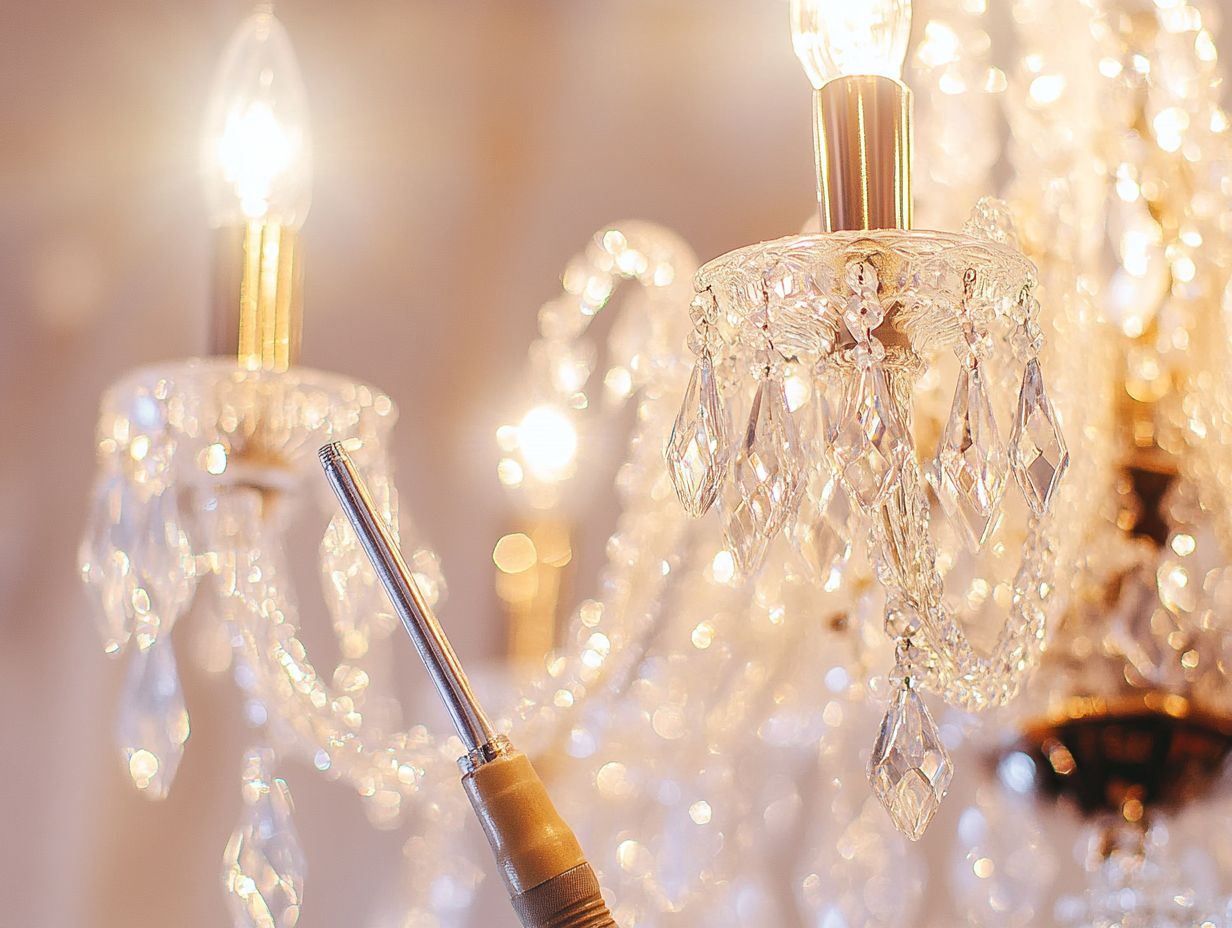
When restoring vintage light fixtures, having the right supplies on hand can truly elevate the outcome. This allows you to achieve an artistic finish while preserving the original design’s integrity.
Select high-quality tools that complement the materials you re working with. For example, microfiber cloths are perfect for gently polishing delicate glass surfaces without scratches. Meanwhile, soft-bristled brushes can effectively remove dust from intricate details without causing damage.
Using specific chemical solutions, like vinegar and baking soda for tarnished metals, will make your vintage fixtures shine like new! With these carefully chosen supplies and an understanding of restoration techniques suited to each material, you can confidently breathe new life into your vintage lighting, showcasing both beauty and functionality.
Step-by-Step Guide to Restoring a Vintage Fixture
Restoring a vintage fixture is an immensely rewarding DIY home decor project. It breathes new life into a cherished piece while preserving its timeless charm. This guide will walk you through the restoration process, covering everything from initial cleaning to the final installation. Each step is executed with care and attention to detail.
Whether you re focusing on a chandelier repair or revitalizing a vintage lamp, following these guidelines will help you achieve a beautifully restored and fully functional masterpiece.
Cleaning and Repairing the Fixture
Cleaning and repairing your fixture requires careful attention to ensure both its aesthetic appeal and functional integrity are maintained throughout the restoration process.
Each material needs a tailored approach. For instance, metal components benefit from the application of fine polishing pastes that remove tarnish without scratches. Glass surfaces need a gentle touch, often using a soft microfiber cloth and a gentle cleaner safe for glass.
With crystal, a careful wash in warm soapy water followed by thorough rinsing and drying can work wonders in restoring its brilliance. It s also important to address common issues like loose fittings or damaged wiring.
Employing appropriate repair methods such as re-soldering connections or replacing missing parts will significantly extend the lifespan of your vintage lighting, ensuring it remains a stunning centerpiece in any setting.
Ready to start your restoration project? Gather your supplies and let your creativity shine!
Replacing Parts and Rewiring
Replacing parts and rewiring chandeliers is a crucial step in restoring vintage fixtures. This ensures both safety and functionality. When dealing with electrical components, following safety protocols is vital to prevent hazards during installation, especially with vintage light fixtures.
Sourcing authentic replacement parts makes your restoration process more effective and enhances the integrity and value of the chandelier.
To start the rewiring process for your vintage chandelier, gather essential tools such as a wire cutter, screwdriver, and a multimeter for testing connections. Have electrical tape and wire nuts handy for secure connections. Always turn off the power at the circuit breaker to minimize the risk of electric shock. For tips on enhancing your lighting, check out this guide on how to style a vintage lighting collection.
When sourcing replacement parts, consider reputable vintage lighting suppliers or online marketplaces that specialize in antique fixtures. For those interested in restoring their pieces, understanding vintage lighting wiring is crucial to ensure that the specifications align with historical standards. This careful attention elevates safety and preserves the aesthetic charm of your vintage chandelier.
Tips for Maintaining and Preserving Vintage Fixtures
To keep your vintage fixtures beautiful and functional, regular maintenance is key. Implement strategies to prevent future damage and preserve the charm of your lighting fixtures.
Regularly clean your fixtures using appropriate methods for various materials. Periodic inspections for wear and tear will help maintain the unique restoration achieved during refurbishing. For those looking to enhance their vintage lighting, learning how to rewire vintage lamps safely can further enrich your understanding of these timeless pieces.
How to Prevent Future Damage
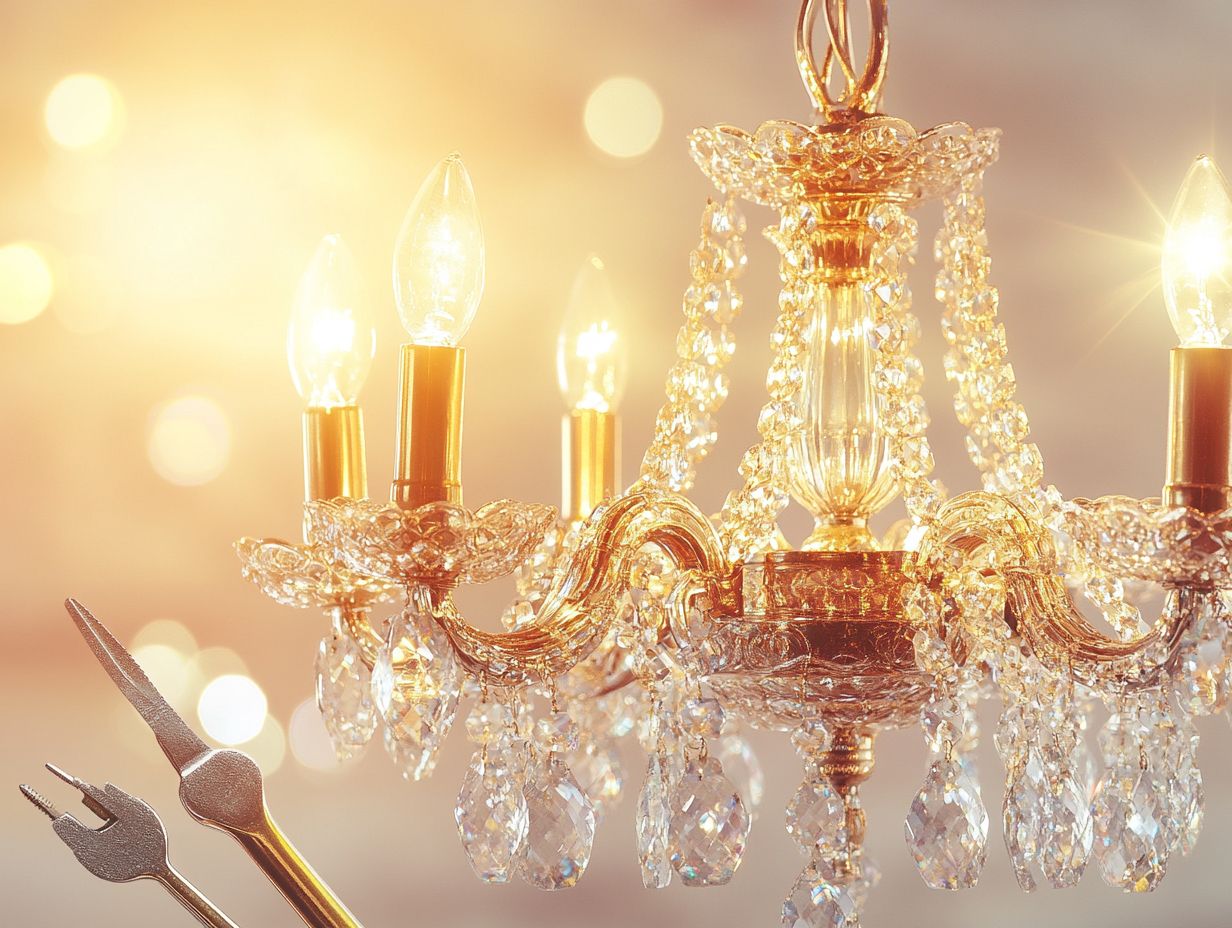
Preventing future damage to your vintage light fixtures involves regular cleaning, ensuring electrical safety, and using proper handling techniques. Avoid harsh chemicals and opt for gentle cleaning methods tailored to different materials. This approach preserves the fixture s integrity while enhancing its charm.
Familiarize yourself with best practices for handling delicate components to reduce the risk of damage during maintenance.
Implementing these strategies will extend the lifespan of these exquisite pieces. For example, using a microfiber cloth lightly dampened with a mild soap solution effectively removes dust without scratching surfaces. Regular inspections of wires and sockets boost safety and ensure efficient performance. Polishing metal fixtures enhances their shine and beauty.
Always turn off the power before performing maintenance. When moving fixtures, support the weight evenly to prevent stressing the joints. Store spare bulbs in a cool, dry place to prolong their lifespan and minimize replacements.
By embracing these ongoing maintenance tips, you can ensure your vintage lighting remains a stunning addition to your d cor for years to come.
Where to Find Vintage Lighting Fixtures
Finding vintage lighting fixtures can be an exhilarating adventure. Explore vintage flea markets, browse online platforms like Etsy, or wander through local antique shops.
Each venue offers unique opportunities for restoration and the thrill of uncovering treasures that elevate your home decor. By knowing where to shop and how to assess potential finds, you can enhance your chances of discovering authentic pieces that align with your style and restoration goals.
Best Places to Search for Authentic Pieces
The best places for you to hunt down authentic vintage light fixtures include vintage flea markets, antique stores, and specialized online platforms dedicated to vintage enthusiasts. These spots often hold unique finds that add character to your home and come with rich stories and histories.
Engaging with knowledgeable sellers can elevate your search experience by offering insights into how to fix and restore antiques and helping you identify quality pieces.
Whether you navigate the vibrant aisles of a flea market or explore meticulously curated online collections, each venue has its advantages. Flea markets are fantastic for uncovering eclectic treasures at competitive prices, while antique stores offer a more refined selection with expert advice.
Online platforms broaden your search horizons, allowing you to compare options and access rare items from around the globe.
Negotiating can lead to great deals! Approaching discussions with respect and flexibility can lead to delightful outcomes. Keep in mind that examining a fixture s craftsmanship, material authenticity, and potential for restoration is essential for spotting those high-quality vintage gems.
Frequently Asked Questions
What are some common issues with vintage lighting fixtures?
Some common issues with vintage lighting fixtures include rust, corrosion, broken or missing parts, and outdated wiring.
What tools will I need to restore a vintage lighting fixture?

You will need a set of screwdrivers, pliers, wire cutters, wire strippers, a wire tester, a soldering iron, and a wire brush. Depending on the condition of the fixture, you may also need sandpaper, rust remover, and replacement parts.
How do I safely rewire a vintage lighting fixture?
First, make sure the fixture is unplugged and all old wiring is removed. Then, carefully follow the manufacturer’s instructions for connecting the new wiring. Have a licensed electrician check your work before use.
Can I clean a vintage lighting fixture without damaging it?
Yes, you can clean a vintage lighting fixture by using a mild soap and water solution with a soft cloth. Avoid using harsh chemicals or abrasive materials, as they can damage the delicate material of the fixture.
How can I repair a broken or missing part on a vintage lighting fixture?
If you can’t find a replacement part, try repairing it with adhesive or using a similar item from a different fixture. If the damage is extensive, it may be best to consult a professional for repairs.
How can I keep my restored vintage lighting fixture safe?
To prevent future damage, dust and clean the fixture regularly and avoid using strong cleaning products. You can also consider updating the electrical connections with modern, more durable wiring to ensure its longevity.

